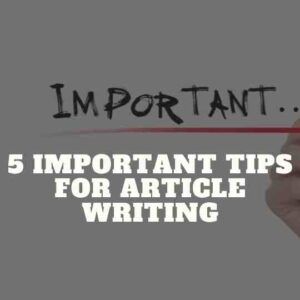What is Article Writing?
Article writing is a written work that is published in a print or electronic medium. It might be for the goal of disseminating information, research findings, scholarly analysis, or discussion. In most cases, it refers to a piece of writing that has been published in a newspaper or magazine. (5 Tips for article writing)
Article Writing Format
When attempting an article writing question, a student must follow the CBSE article writing pattern. The article writing structure is shown in detail here.
An article’s format is made up of the following elements:
Heading,
line by line
Body
Header– The heading should be short and to-the-point, with no more than 5-6 words.(5 Tips for article writing) You may be as inventive as you want with this one, but don’t spend too much time on it during the exam.
THE NAME OF THE PERSON WHO WROTE THE ARTICLE IS DESCRIBED BY LINE. It’s usually included in the query. Don’t write your personal information if it isn’t requested.
(NOTE: When attempting the exam’s responses, you are not allowed to reveal any of your personal information.)
The BODY is the most important element of your essay. It is usually 3-4 paragraphs long.
PARAGRAPH 1: It is usually recommended that you begin with a brief overview of the issue; to be specific, it’s significance. Briefly describe the topic of the piece, using relevant quotations or surprising information to pique the readers’ attention.
PARAGRAPH 2 (or 2&3): This section can now be written in one or two paragraphs. You must conduct a thorough examination of the subject matter at hand. It might consist of:
TYPES – How many different forms does the problem take? You must list the numerous varieties that are feasible (if it exists).
Present SCENARIO – Next, describe the current situation, any difficulties (if any), and whether or not the situation has improved as a result of any remedial efforts.
Depending on the topic, it may have pros and downsides.
RELATIONSHIP BETWEEN CAUSE AND EFFECT– Support the cause and effect relationship using facts or statistics. You may also write the ramifications.
Any extra information that is useful and linked.
The conclusion is in PARAGRAPH 3 or PARAGRAPH 4. It’s the last sentence in the paragraph. It’s critical to finish what you’ve begun. Never conclude an article on a cliffhanger. It’s important to remember that whenever you describe an issue, you must always include the measures you’re taking to improve the situation and provide a few options. It’s possible to add predictions and personal issues. This paragraph should be succinct and precise. You might also use some quotations to add some sparkle to your art project.
5 Important Tips for Article Writing

A topic is required before you can begin writing an essay or article. However, a fantastic topic is merely the beginning of a wonderful post. Other vital ideas can boost your end-product in addition to the basic technical features such as structure that enhance your project.
Fluff does not make a storey more engaging, but an active voice does. Excessive rambling is distracting, but short, interesting thoughts on paper keep the audience’s attention. These five pointers can help you improve your writing skills.
Plan your article structure
No matter what form of writing you undertake, the framework is crucial. There should be a beginning, middle, and end to whatever you write. There are a few exceptions to this rule, and they usually involve SEO articles aimed to produce backlinks.
The rest of your structure should incorporate these three aspects, and your headers and subheadings should provide a general overview of your piece to the reader. Each heading should include an introductory statement that captures the substance of the heading. The final phrases beneath each title should establish your next paragraph’s main idea.
Make a list of tools and applications that can assist you with article structure and general writing from beginning to conclusion. The Edubirdie tool is an excellent recommendation from expert academic writers. It’s the greatest way to check your work for plagiarism for free. It may be used not only for articles, but also for all types of academic work such as theses, dissertations, and essays.
Choose a topic you’re interested in
If you’re passionate about your subject, it will show in your writing. When you appreciate your subject, you can study and write more quickly. Unless you spend a lot of time undertaking in-depth research, your writing might rapidly become uninteresting if you have nothing to say about a topic.
It is much easier to produce a result that keeps your audience attention while writing an essay about an academic subject or a creative piece about something you are enthusiastic about.
Show creativity and clarity of thought
It’s fantastic to have facts, but it’s much better to have clear creativity.
I am a member of a family.
My family consists of my wife, two children, and one son. My older daughter is a violinist, while my younger daughter is a ballet dancer. My oldest son is my firstborn and is currently a university student. My youngest child, my second son, is currently in seventh grade.
The second phrase provides a clearer picture of his family to the reader, making for a considerably more engaging read.
6 Best Ad Networks for Publishers [in 2021]
Simple language works better
To make your argument without looking uninformed, use basic phrases. The goal of today’s writing is to make it as simple as possible to read. To reach this goal, modern writing should be built for speedy comprehension, therefore apply these techniques to improve your work.
Use “use” instead of “utilise,” “nearby” instead of “close proximity,” and “start” instead of “commence.” When shorter words aren’t going to cut it, use longer ones. Simple!
Active is much more interesting than passive
The subject comes first, followed by the verb, and then the object in the active voice. In English, this formula is referred to as the SVO. Although it is not always feasible to achieve the SVO in every phrase, try to employ the active voice more often than the passive voice.
This formula is reversed in the passive voice, resulting in the OVS—-object, verb, subject. The active voice is usually far more engaging than the passive voice. Most writing software applications allow you to examine how much of your piece is written in active and passive voice. For your passive voice, aim for a percentage of at least 20%.
